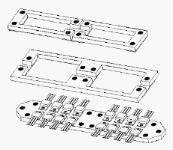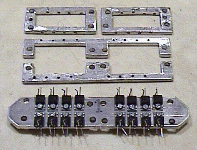August 2002
Thursday 1st August 2002
After my experiment with driving my winch motors on 24 volts and blowing up another couple of MOSFETs, I was now seriously low on spare MOSFETs, so I sent an e-mail off to Fairchild groveling for a few more sample devices. They responded very quickly and positively and said I could have some more samples. I initially asked for 20 devices, which should allow me to rebuild the complete H Bridge driver using some of the existing spares I already had.
However, a bit of bad news came back saying that the particular MOSFETs I had been using were now obsolete! There were no real alternative that could handle the same current as these since these were rated at 140 amps, while the nearest alternatives were 80amps. Another day later my contact Hank said he had located the last few remaining ones in Fairchild's bowels, which he was happy to send me.
Today these arrived, all 100 of them!! Even if I blew the complete H bridge circuit up three times I will still have enough spares, to keep me going. Thanks Fairchild, you've done me proud again.
I also received e-mails from SKF to say they were happy to continue supplying me with bearings; all I had to do was drop Steve a line with the items I wanted, and he would put them in the post.
RS too replied to my pleading e-mail for a new set of catalogues, which are an invaluable source of information as well as making selecting components a whole heap easier than using a website. What can I say but thanks sponsors once again for your continued support!
The other area I wanted to look a bit closer at was my pneumatic flipper. While being "tech checked" by George Francis during the Series 6 event, I couldn't miss the opportunity to pick his brains, so asked him which areas I needed to focus on in order to build a real flipper rather that a "limp lifter" that I currently had. Should I use a full pressure system or can I get away with a low-pressure system?
George said that he was very impressed with the robot M2 as built by the Technobot guy Paul. He had competed against it recently and was very impressed with its performance. Paul had managed to build the flipper as powerful as Chaos 2's using low pressure pneumatics (well 16 bars anyway). The secret was using large enough rams, a suitably large buffer bottle, and large pipe work to get a fast flow of gas. George told me to log onto the Technobot's web site where they had some technical guide notes explaining all the relevant parts. I have to complement the Technobots guys because their notes are very good, and I will be taking onboard many of their recommendations.
You can buy just about all the necessary parts from Technobots, but they are not cheap. Before I parted with my hard earned cash, I decided to sent a few groveling e-mails out to a number of pneumatic supplier to see if any of them would sponsor me. I wonder if my luck is going to stand up to this fairly demanding test?
Friday 2nd August 2002
I had a response back from Norgren (the pneumatics company) who said they should be able to help me with pneumatic parts. The guy who phoned me was very positive and said he would arrange for a local Norgren representative to contact me and discuss my requirements.
There is no firm commitments, but it all looks very premising and I will be keeping my fingers crossed!
Saturday 10th August 2002
I decided to have a go at updating my trusty MOSFET bricks. The old ones were a little fragile, and not easy to maintain if a transistor blew up and needed changing.
|
First of all I wanted to replace the individual wires that were soldered to the MOSFET leads since replacing a MOSFET was a fiddly task because of the many wires, and it took some time to change one if I wasn't to damage the MOSFET in the process. The next thing I wanted to do was use a bus bar type of arrangement to feed power into, and out of the MOSFETs. It would give the whole brick a bit of rigidity, as well as having a greater current carrying capacity. I drew a few diagrams out on the computer and then went about cutting and filing the parts out of some 6mm aluminium plate. |
 |
Saturday 24th August 2002
I received a letter from Mentorn with my appearance money of 100 pounds in it. The letter accompanying it talked about the possibility of another competition later on in the year. No dates, theme or places were given, but if I want to have a go, I will need to move fast with building Hassocks Hog 2. Alternatively I will have to get Hassocks Hog 1 back on the road.
Saturday 31st August 2002
| I had cut out the plates for one motor controller MOSFET brick during the week, and now decided to mount the MOSFETs on it, and bolt the whole thing together. During the week I had bought a "cheap and cheerful" drill stand from Screwfix because I knew I had a lot of holes to drill, and wanted to make sure they were all in the right position. Drilling small 3mm holes by hand can be a haphazard affair, so I thought the new drill stand would ensure that when they were marked out on the metal plates, they would all end up beautifully in line. No such luck! The stand may have been "cheap", but the results certainly weren't "cheerful". The stand had a small amount of play as the assembly slit up and down the vertical shaft, which meant that as I lowered the drill onto the center punch marks, it would jitter about in the hole. This meant that some holes ended up being in line with the center punch marks while others would be skewed out of line by a millimeter or so in one direction or another. This was not quite enough to cause major problems with aligning things up and bolting the assembly together, but it did make the assembly look a bit amateurish and shoddy. I suppose you get what you pay for in the workshop, and if you pay peanuts, you can't expect quality! |  |